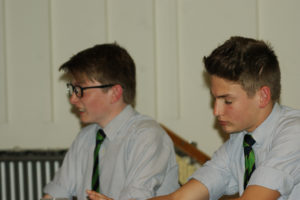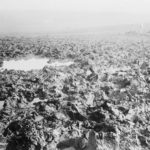Can you dig it? – Sam Christmas
When Dad first mentioned that I should spend a couple of weeks on an archaeological excavation I wasn’t sure if he was joking. At first, I was interested, Indiana Jones was an archaeologist and he seemed to enjoy an adventurous and fulfilling life. However, there was one problem with that line of thought: Indiana Jones is also fictional.
I was astonished to learn that my Dad didn’t know me at all, a recurring thought after I received a copy of the Hobbit, one of my favourite books… but in Latin – aged eleven. Two weeks hacking the soil for the chance of discovering a few old bones and some broken pottery didn’t sound like my cup of tea at all. However, anyone who knows my father will know my opinion mattered very little and soon I was looking online for an opening. Yet, there were also several problems with the possibility of my going:
- i) I didn’t have a beard – anyone who has seen TimeTeam knows the only criteria for archaeology is being able to sport an impressive display of facial hair.
- ii) It was in the summer – the thought of missing several weeks of cherished holiday didn’t evoke much optimism on my behalf.
iii) The extensive geekiness – despite being a self-confessed geek there was a line (or so I thought) which one doesn’t cross and archaeology, much to the affirmation of my ‘friends’, is very much beyond it.

In the end, these problems were all overcame. It turned out that I was really was enough of a geek to spend two weeks attempting to uncover the mysteries of Romano-Celtic Dorset. I was presently surprised to learn that I was able to miss a week of school and, as any self-respecting RHS pupil will tell you, this greatly outshone any negatives of attending the excuse to escape for a few days. So two problems down, however, for the third I had to make do with the bit of bum fluff on my chin.
There was a period of waiting. In fact apart from signing on to the dig, archaeology had pretty much escaped my mind until the twenty third of March. Waking up on the morning of my birthday, I began my day with the usual celebratory activities associated with birthdays; it was the present opening which is really relevant in this narrative. Among the presents which had collected in the living room there was one curiously shaped package, my interest caught I investigated.
Unwrapping this present I revealed the item which triggered the return of Archaeology back into this story. My dear father had bought me a trowel. Before I continue I must explain to some of our more troglodytic readers that the tool of choice for an archaeologist is, in fact, not a whip, as shown in Spielberg’s films, but the humble trowel. Needless to say I was overjoyed to be receiving this on my seventeenth birthday.
Skipping forward several weeks it came to the period of the year where any and all students are not only allowed but encouraged to develop as people, Enrichment Week. Through intense negotiation I was able to hitch a ride west with the Geography department. Indeed there are many similarities between geographers and archaeologists: beards, walking boots and a fascination with the ground are shared. Yet, where archaeologists use rocks to identify relics of the past which can help expand our knowledge of history, geographers confirm that these rocks are indeed rocks. Needless to say, both are equally valid. I found myself and the Mackenzie Mafia hurtling down the motor way in one of the school’s nice grey minibuses. Soon we had reached Longleat, the fork in the road where my path separated from my crayon-wielding water-cyclists.
The next day I reached the destination of discovery, Winterbourne Kingston. Sadly I had got the times wrong so I spent the first hour of my enrichment week sitting alone in an empty field. Soon my fellow archaeologists arrived, saving me from using my trowel on myself. There was a sizeable amount of undergraduates from Bournemouth University as well a cohort of volunteers such as myself. In truth the two different groups can be described as those who knew what they were doing and those who only thought they did. The professor in charge of the dig was, much to the excitement of those assembled, a TimeTeam veteran, beard and all. After giving us a site tour and assigning us to different trenches he sent us off to roles.
Excitingly I was designated as wheelbarrow operator for the first couple of hours – this comprised me carrying all the waste rocks and earth excavated by the archaeologists on the front line. After being assured this was the standard task for new diggers I took to my task with renewed zeal. During my time moving rocks I learnt that I am probably not best suited to manual labour or any labour come to speak of it. After this it was my time: I was allowed to start my own feature. Foreseeing gold and human bones I quickly established my feature in the chalk, a geological blessing, and set about marking it. Breaking the top soil seemed akin to slave labour probably used on the fields two thousand years ago; however, unlike them, I had to remind myself, I volunteered for this. To make matters more difficult it was boiling hot: the combination of the white chalk reflecting the sun’s rays and my pale skin ensured I burnt in my normal tomato fashion. However, as I was regretting ever signing up my trowel scraped away some earth to reveal a shard of pottery. Now, while this may not seem particularly exciting, the delirium and my natural fascination for Classical antiques turned this insubstantial piece of burnish-ware seemed like gold dust to me, holding the shard to my chest in a surprisingly Gollum-esque manner I realised that archaeology is for me. There is a certain romance to clutching something made by a person two thousand years ago, knowing that the last person held it had no comprehension that his pot would survive him by two millennia only be found on a Monday in June by a small, slightly burnt enthusiast.
Other highs of the dig were discovery half the skeleton of a four thousand year old sheep, presumably herded by the pot-maker’s ancestors. Right next to my feature, three adult human skeletons were found and a child’s, rather tragically. But no matter if one finds something great or little, archaeology makes you appreciate the smaller things in life, whether they be archaeological remains, suncream or four thousand year old sheep. Despite, misgivings I actually enjoyed myself, what can I say archaeology is just addictive.















Post Comment
You must be logged in to post a comment.